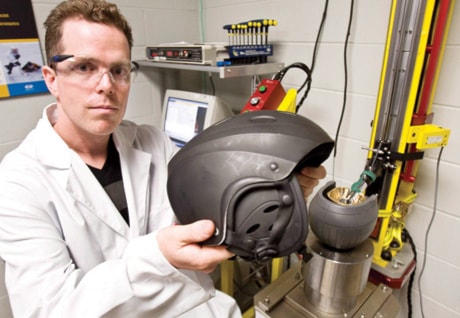VANCOUVER — Karen Condon’s world turned upside down on Feb. 20, 2007, when a snowboard went through her son’s skull, shattering it like a cracked egg shell.
At first, Condon was told her teenager just needed stitches — he’d walked into the ambulance and seemed OK.
But the nurse from Bonshaw, P.E.I., said she knew things were bad when Ryan Condon, then 16, was transferred from the local hospital to Moncton, N.B.
There, he underwent four hours of brain surgery.
“The doctor said it was like when you crack an egg shell, the skull was in pieces,” Condon said.
“Is my kid going to live or is he going to die? That’s what I was thinking,” she said of seeing her son after the operation.
Ryan Condon said he was trying to avoid a collision with a buddy on a hill near their home while snowboarding when his buddy’s snowboard hit him on the left side of the head and entered his skull.
That’s what friends have told him happened that day.
“I don’t remember what happened from about four hours before to about 15 minutes after,” said Condon, who is now doing well.
He wasn’t wearing a helmet, and that’s the biggest lesson he’s learned from his harrowing experience.
Since then, his mother has become an advocate for legislation that makes helmet use for skiers and snowboarders mandatory — the same as for cyclists in some provinces.
“I don’t want anyone going through what we had to go through,” she said. “We need to make sure our young people, or whoever’s skiing and snowboarding, are protected.”
Condon also wants snow sport helmets sold in Canada to be certified by the Canadian Standards Association, but the federal government has so far refused to move forward with a private member’s bill that could make that happen.
“I know there are a lot of people who do wear helmets when they ski or snowboard but they’re not CSA-approved and I’ve been telling them that,” she said.
World Cup winner and two-time Olympian Dave Irwin, known as the Crazy Canuck for his daredevil downhill racing style, suffered a brain injury in March 2001 after a crash during a training run in Banff National Park.
Irwin, 55, was wearing a helmet but it didn’t protect him when he bashed his knee into his forehead below his helmet and then his head hit the snow.
Without the helmet, his injuries could have killed him, said his long-time girlfriend Lynne Harrison.
Irwin said he’s had a history of spectacular crashes over the years, even breaking his back, and has been hospitalized with head injuries three times. He said little is known about brain injuries, but one thing is clear: Those related to sports are becoming more common and that requires new laws to make helmets mandatory.
“I’ve always been a guy who’s never liked a lot of rules and regulations in life,” he said, stopping mid-sentence as he forgets the question he’s been asked.
That’s one of the effects of his injury, which also caused him to lose memory of about five years of his life before the accident and that many more afterwards, said Harrison.
She said a therapist at Foothills Hospital in Calgary said Irwin had the worst case of amnesia he’d ever encountered. Despite that, he’s passionate in speaking publicly about the importance of wearing helmets during snow sports activities, Harrison said.
He has even set up the Dave Irwin Foundation for Brain Injury Recovery to raise money for awareness and prevention programs through the annual Dash for Cash event in Banff.
“This is something very simple, very smart,” he said about legislating helmet use. “Brain injuries hurt people a lot and yes, we can protect people.”
“Let’s fix it. Let’s insist that people put helmets on.”
Often, parents buy their children helmets but don’t wear the head gear themselves, he said.
According to Safe Kids, international data show head injuries account for between three and 15 per cent of injuries to skiers and snowboarders, but make up 87 per cent of deaths.
Among children, the group says brain injuries account for 67 per cent of deaths.
Harry Zarins, executive director of the Brain Injury Association of Canada, said the legislated use of helmets for snow sports may require a “cultural change.”
“We’re facing the same challenges that people had with seatbelts 30, 40 years ago.”
The issue of helmet use resurfaced after actress Natasha Richardson died in April after falling at the Mont Tremblant ski resort in Quebec.
In October, Vancouver-based Intrawest, which operates 10 ski resorts across North America, announced it will recommend that all skiers and snowboarders wear helmets this season.
The headgear will be mandatory for children and teens enrolled in ski and snowboard lessons and for any student, regardless of age, taking part in freestyle terrain park programs.
